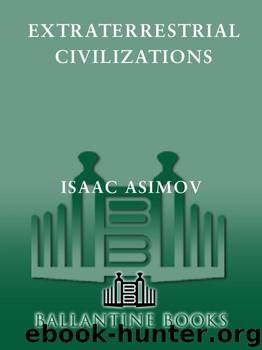Extraterrestrial Civilizations by Isaac Asimov

Author:Isaac Asimov
Language: eng
Format: mobi, epub, azw3
ISBN: 9780307792303
Publisher: Random House Publishing Group
Published: 2011-04-20T10:00:00+00:00
HABITABILITY
The mere fact that a planet is in the ecosphere does not mean that it is a suitable abode for life; that it is habitable, in other words.
For proof of that we need look no farther than our own Solar system. The Earth itself is the only planet in the Solar system that is clearly within the ecosphere of the star it circles. Our definition of the word planet, however, obscures the fact that there are two worlds in the ecosphere just the same.
The Moon, strictly speaking, is not a planet, because it circles the Earth (or rather the Earth-Moon center of gravity, which the Earth also circles), but it is a world. What’s more, it is a world that is just as firmly within the ecosphere as the Earth and yet the Moon is not a habitable world.* The Moon clearly has too little mass to be habitable, since because of its small mass it cannot retain an atmosphere or liquid water. What, then, can we say about the masses of planets?
As I have said in the case of Population II stars where the only materials for planetary structure are hydrogen and helium, the only possible planets would seem to be giants with the mass of Uranus or more. Nothing less would possess the gravitational intensity that would make it possible to hold on to hydrogen and helium.
In the case of Population I stars, which are the only ones we are considering as suitable incubators for life, we have metals, rocks, and ices in addition to hydrogen and helium for uses as structural materials. Again here, only giant planets can make use of the hydro-gen and helium, and it is precisely because they can that they are giant planets.
On the other hand, where Population I stars are concerned, smaller worlds of all sizes can be built up of metals, rocks, and ices, since these will hold together through forces other than gravitational.
How large can these smaller worlds be?
Not very large, for even among Population I stars of the second generation, the quantity of materials other than hydrogen and helium is rather small, and cannot be used to build a large world. And if these stars could, they would gather hydrogen and helium and become giant worlds.
Dole’s computer simulations of planetary formation make it seem pretty clear that within the ecosphere of Sunlike stars those planets that are not giants are quite small.
How large and massive can a nongiant planet be?
If we exclude the four giant planets of the Solar system (and the Sun itself, of course), then the largest body in the Solar system is none other than the Earth itself.
Earth is, therefore, very likely to be near the top limit of mass for nongiant, nonhydrogen planets.
A planet somewhat larger than Earth, but not much larger, would, if all other factors were suitable, surely be habitable. The one unavoidable consequence of the greater mass would be a more intense gravitational field, which might manifest itself as a somewhat higher surface gravity.
Download
Extraterrestrial Civilizations by Isaac Asimov.epub
Extraterrestrial Civilizations by Isaac Asimov.azw3
This site does not store any files on its server. We only index and link to content provided by other sites. Please contact the content providers to delete copyright contents if any and email us, we'll remove relevant links or contents immediately.
| Aeronautics & Astronautics | Astronomy |
| Astrophysics & Space Science | Comets, Meteors & Asteroids |
| Cosmology | Mars |
| Solar System | Star-Gazing |
| Telescopes | UFOs |
Tools of Titans by Timothy Ferriss(8218)
Turbulence by E. J. Noyes(7936)
Secrets of Antigravity Propulsion: Tesla, UFOs, and Classified Aerospace Technology by Ph.D. Paul A. Laviolette(5309)
Astrophysics for People in a Hurry by Neil DeGrasse Tyson(5130)
Room 212 by Kate Stewart(5035)
Design of Trajectory Optimization Approach for Space Maneuver Vehicle Skip Entry Problems by Runqi Chai & Al Savvaris & Antonios Tsourdos & Senchun Chai(5011)
Pale Blue Dot by Carl Sagan(4912)
The David Icke Guide to the Global Conspiracy (and how to end it) by David Icke(4625)
A Journey Through Divination and Astronomy by Publishing Pottermore(4344)
Goodbye Paradise(3726)
Apollo 8 by Jeffrey Kluger(3637)
COSMOS by Carl Sagan(3554)
Losing the Nobel Prize by Brian Keating(3498)
The Five People You Meet in Heaven by Mitch Albom(3474)
How to Read Water: Clues and Patterns from Puddles to the Sea (Natural Navigation) by Tristan Gooley(3406)
Brief Answers to the Big Questions by Stephen Hawking(3369)
How to Read Nature by Tristan Gooley(3249)
The Order of Time by Carlo Rovelli(3145)
A Brief History of Time by Stephen Hawking(2960)
